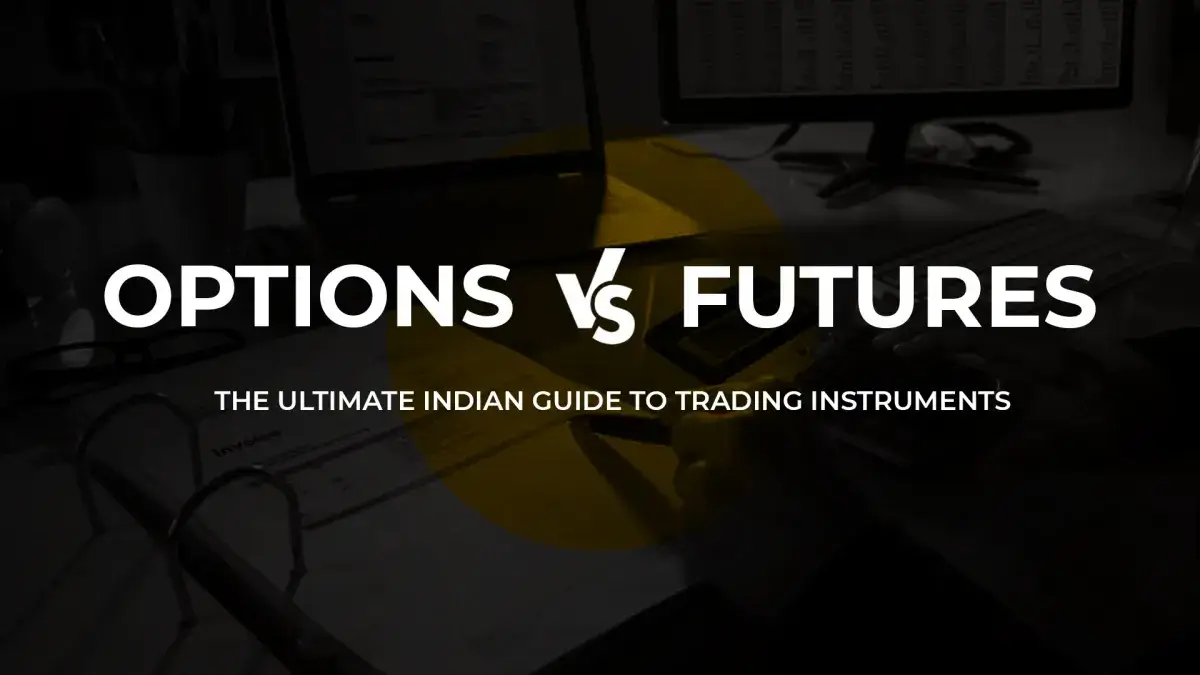Options Vs Futures: The Ultimate Indian Guide to Trading Instruments

Here's What We've Covered!
Are you also one of those people who can’t decide between idli-sambar and masala dosa when you go out for breakfast? Well, the world of trading has something similar – options and futures. And guess what, we at IMS Proschool are here to help you make an informed decision (and we promise, this time you won’t be drooling over your options).
In this blog, we’ll dive into the world of options and futures and explore their differences, pros, and cons. And if you’re keen on learning options trading, you’re in luck! IMS Proschool is your one-stop destination to become an options trading guru. So, let’s jump right in!
What are Options and Futures?
Picture this: you’re at a cricket match and want to bet on your favourite team (in a friendly way, of course). In the world of trading, you can bet on the performance of financial instruments like stocks, commodities, and currencies. And that’s where options and futures come into play.
- Options: These are financial contracts that give you the right, but not the obligation, to buy or sell an underlying asset at a specific price on or before a certain date. Think of it as having the option to eat that last piece of gulab jamun, but only if you feel like it.
- Futures: These are financial contracts that obligate you to buy or sell an underlying asset at a specific price on a future date. Imagine being forced to finish all the dishes your mom made for dinner, whether you like it or not.
Now that we have a basic understanding of options and futures let’s take a look at their differences. Once you understand the differences, we’ll go through detailed examples to understand both – Options & futures.
Comparison between Options & Futures
| Parameter | Options | Futures |
| Obligation | For Option Buyer – No obligation to buy/sell the asset
For Option Seller – Obliged to buy/sell the asset |
Obliged to buy/sell the asset |
| Premium | Buyers pay a premium; sellers receive the premium | No premium involved |
| Expiration Date | American Option – Can be exercised on or before the expiration
European Option – Settled on the expiration date |
Settled on the expiration date |
| Risks & returns | High risk, high expected return | High risk, high expected return |
So, now you have a snapshot of the differences between options and futures. But don’t worry, we’ll dig deeper into each aspect in the coming sections.
Read – Options Trading For Beginners: How To Generate Consistent Profits
Real-Life Examples of Options and Futures Trading
Adding some real-life examples to our discussion can help illustrate the concepts and strategies we’ve covered so far. So let’s dive into two examples from the Indian market that highlight the practical aspects of options and futures trading.
Example 1: Options Trading – Infosys Limited
Let’s say you believe that Infosys Limited’s stock price will rise in the near future due to a positive earnings announcement. You decide to buy a call option with a strike price of ₹1,500, expiring in one month, for a premium of ₹50 per share. Here’s how this trade could play out:
- If Infosys’ stock price rises to ₹1,600 before the option expires, you can exercise the call option and buy the shares at the strike price of ₹1,500. You’d make a profit of ₹50 per share (₹1,600 – ₹1,500 – ₹50 premium).
- If the stock price doesn’t move or falls below ₹1,500, you can simply let the option expire, and your loss is limited to the premium you paid (₹50 per share).
This example demonstrates the limited risk and potential profit associated with options trading.
Example 2: Futures Trading – Reliance Industries Limited
Suppose you expect Reliance Industries Limited’s stock price to increase over the next three months. You decide to buy a futures contract for 100 shares of Reliance Industries at ₹2,200 per share, expiring in three months. Here’s what could happen:
- If Reliance Industries’ stock price rises to ₹2,300 before the contract expires, you’ll make a profit of ₹10,000 (100 shares x (₹2,300 – ₹2,200)
2. If the stock price falls to ₹2,100, you’ll incur a loss of ₹10,000 (100 shares x (₹2,200 – ₹2,100)
This example highlights the leverage and potential risks involved in futures trading.
These real-life examples emphasize the differences in risk management and potential rewards when trading options and futures. Remember, the choice between options and futures ultimately depends on your trading objectives, risk appetite, and personal preferences.
Pros and Cons of Options and Futures
Now that we’ve compared options and futures let’s break down the pros and cons of each. It’s like choosing between vada pav and samosa; both have their unique flavours and appeal to different taste buds!
Options – Pros:
- Limited risk: Buying options has limited risk, just like eating one gulab jamun at a wedding – you know you can’t go overboard!
- Flexibility: Options offer more flexibility in terms of exercising or trading the contract. It’s like having an extra chutney option at the chaat counter.
- Customizable strategies: Options allow you to create various strategies to hedge, speculate or generate income. It’s like mixing and matching your favorite street food.
Options – Cons:
- Time decay: Options lose value as they approach their expiration date, similar to how your interest in leftover pizza decreases over time.
- Complexity: Options can be more complex than futures, just like understanding the twist at the end of a Bollywood movie.
- Higher brokerage fees: Options trading often comes with higher brokerage fees, which is like paying extra for that premium ice cream at the end of a meal.
Want to start learning options trading?
Futures – Pros:
- Leverage: Futures offer more significant leverage, which can lead to higher profits. It’s like getting an extra-large thali at a restaurant – more bang for your buck!
- Simplicity: Futures are relatively simpler than options, like watching a classic Bollywood rom-com – no complex plot twists to worry about.
- Liquidity: Futures markets are often more liquid, ensuring smoother transactions. It’s like finding a rickshaw during peak hours – easier than you thought!
Futures – Cons:
- Unlimited risk: Futures come with potentially unlimited risk, like trying to eat extra-spicy pani puri – you never know when it’ll become too much to handle.
- Obligation: Futures contracts are binding, meaning there’s no backing out. It’s like being forced to eat all the food on your plate at a family dinner.
- Margin calls: If the market moves against your position, you may face margin calls, which is like being asked to pay extra at a buffet because you didn’t finish your food.
Who should choose options and who should choose futures?
As we’ve seen, options and futures cater to different tastes, just like how some people prefer aloo parathas and others go for paneer tikka. So, let’s explore who should choose options and who should opt for futures.
Choose options if you:
- Want limited risk: If you like playing it safe, options are your best bet. Think of it as choosing a tried-and-tested dish at a restaurant.
- Prefer flexibility: Options give you more freedom to exercise or trade the contract. It’s like having multiple choices for dessert.
- Have a smaller capital: Options trading requires less initial capital, which is perfect if you’re on a budget but still want to enjoy a delicious meal.
Choose futures if you:
- Seek leverage: If you’re looking for higher returns and don’t mind the added risk, futures can be a good choice. It’s like ordering the spiciest dish on the menu and hoping for the best.
- Appreciate simplicity: Futures are less complex than options, so if you prefer a straightforward approach, they’re for you. It’s like enjoying a simple home-cooked meal.
- Have a larger capital: Futures trading requires more initial capital, so if you’re willing to invest more, it might be the right choice. It’s like splurging on a fancy dinner.
Are Options Better Than Futures?
The million-dollar (or should we say, crore-rupee) question is: are options better than futures? Well, it’s like comparing Shah Rukh Khan and Amitabh Bachchan – both are iconic in their own right, but they cater to different preferences.
Options have their unique advantages:
- Limited risk: Options have limited risk for buyers, making them a more cautious choice. It’s like opting for mild spices when trying a new dish.
- Flexibility: The ability to exercise or trade options gives you more control over your trading strategy. It’s like deciding whether to eat in or take out from your favorite restaurant.
- Customizability: With options, you can create various strategies to suit your trading objectives. It’s like customizing your pizza toppings to make it perfect for your taste buds.
Futures, on the other hand, offer some distinct benefits:
- Leverage: Futures provide more significant leverage, which can lead to higher profits. It’s like going all-in with extra cheese and toppings on your pizza.
- Simplicity: Futures are relatively simpler than options, making them easier to understand for beginners. It’s like sticking to the classics in a Bollywood playlist.
- Higher liquidity: Futures markets tend to be more liquid, ensuring smooth transactions. It’s like getting a table at a popular restaurant without a reservation.
Ultimately, whether options are better than futures depends on your personal preferences, risk appetite, and trading objectives. Just like some people prefer paneer tikka masala while others can’t resist butter chicken, the choice between options and futures is up to you.
Why Choose IMS Proschool for Options Trading Education?
Now that you’ve explored the world of options and futures, you might be eager to kick-start your trading journey. And if options trading has piqued your interest, look no further than IMS Proschool!
Here’s why IMS Proschool is your one-stop destination for options trading education:
- Riskless Mock trading on Sensibull: Hone your skills with our risk-free mock trading platform, Sensibull. It’s like practicing your dance moves before hitting the dance floor at a wedding.
- Eligible to appear for NISM Series 8 Certification: Get the credentials you need to excel in the trading world with our NISM Series 8 Certification eligibility.
- No prior knowledge required: Start from scratch and learn everything there is to know about options trading. It’s like learning how to cook mouth-watering biryani from scratch.
- Access to 100’s of curated jobs: Find your dream job in the trading world with our curated job opportunities. It’s like being invited to an exclusive, members-only dining experience.
- Starting salaries around 4-5 LPA: Kick-start your career with a competitive salary package. It’s like being rewarded with a delicious dessert after a satisfying meal.
- Faculty with 15+ years of combined experience: Learn from the best in the business – our experienced faculty have a combined trading experience of 15+ years. It’s like learning culinary secrets from a master chef.
- 4-month options trading course: Master the art of options trading with our comprehensive 4-month course. It’s like perfecting your recipe for gulab jamun over time.
So, what are you waiting for? Embark on your options trading journey with IMS Proschool and spice up your financial life like never before!
Resent Post
>
Emerging commerce career options in India (2026): From CA to Data Analyst
>
ACCA Opportunities You Didn’t Know About – Think Beyond Audit!
>
Which Courses After 12th Commerce With High Salary Are in Demand Worldwide?
>
How to Find ACCA Jobs Online After Qualifying: Real Portals, Tips & Career Guidance
>
Financial Modelling Classes in Hyderabad: Your Guide to the Best Institutes
Follow Us For All Updates!



